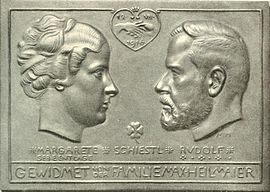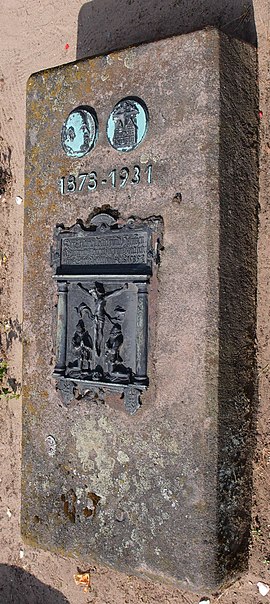Rudolf Schiestl

Rudolf Schiestl (born August 8, 1878 in Würzburg , † November 30, 1931 in Nuremberg ) was a German painter , etcher , graphic artist and glass painter.
life and work
After attending elementary school at the age of 12, Schiestl started his father's apprenticeship like his brothers Heinz and Matthäus . His father, a sculptor, came from the Zillertal in Tyrol, his mother Maria Schiestl, nee. Adamer ("Farmer's Daughter for Corn") from Unterkampfen (Lower Inn Valley) also in Tyrol. Early contact with medieval sculpture, some of which were restored in his father's workshop, as well as drawing after engravings and cuts by Dürer , Schongauer , Schwind and others, as well as sketch excursions to the Lower Franconian villages had a strong influence on his artistic development.
In 1896 he went to the academy in Munich to Prof. Hackl , after two semesters in the painting class of Franz von Stuck . In his own opinion, this academy time was not very fruitful for him. His studies of nature and the close contact with the life of the people rather pointed the way for his later development.
In the summer of 1899 Rudolf Schiestl worked in the Tyrolean glass painting in Innsbruck . In 1900 he created wall paintings - partly in collaboration with his brother Matthäus - in the Palatinate, including in Germersheim , Landau , Kaiserslautern and in the Anna Chapel in Burrweiler . Around 1900 he designed for the Cologne chocolate producer Ludwig Stollwerck Stollwerck collection pictures for the Stollwerck collection album No. 3. In 1901 he started his own business, a. a. as a commercial artist with stone drawings, illustrations, posters. On his three trips to Italy he got to know the tempera technique, which he implemented in the painting technique studies at the Munich Pinakothek and, in his own words, "discarded the academic knowledge that had been painfully acquired". He spent most of the summer months in Würzburg. The King of Romania acquired two paintings from this period.
In 1910 he was appointed professor at the Nuremberg School of Applied Arts as a teacher of graphics. He was now able to deal intensively with the art of etching, in which he trained himself through self-study. Franconian landscapes, peasant pictures, religious themes and occasional graphics were created.
In 1916 he married the writer Margarete zur Bentlage , who was his student at the time. Shortly after the marriage he had to enlist in the army, where he was at the front in French Lorraine from July to November 1917.
In 1917 he was the artistic director of the Liller war newspaper as the successor to Karl Arnold and then a draftsman for the newly founded army newspaper Heer und Heimat in Brussels . Back in Nuremberg after the end of the war, he worked intensively with glowing colors and implemented this in the reverse glass paintings (Annunciation, etc.). In the following years, in addition to larger etchings, woodcuts in particular (Der Tod von Basel et al.) In the Der Deutschen Spielmann series, he designed and illustrated four booklets. From 1927 he mainly devoted himself to painting.
After a long illness, Rudolf Schiestl died on November 30th, 1931. He was buried in the historic Johannisfriedhof in Nuremberg not far from the grave of Albrecht Dürer.
Gustav Schickedanz had created one of the largest Schiestl collections .
Works
- The death of Basel : eight woodcuts by Rudolf Schiestl for the old folk song . Heyder, Berlin 1924 ( urn : nbn: de: hbz: 061: 1-76855 , digitized edition of the University and State Library Düsseldorf )
gallery
Pilgrimage to Gößweinstein
Known students
- Richard Rother (1890–1980), sculptor and wood cutter
- Hermann Wilhelm (painter) (1897–1970), painter and professor
- Alf Depser (1899–1990), chemist, painter, draftsman, wood cutter and graphic artist
- Karl Hemmeter (1904–1986), sculptor and wood cutter
- Alfred Finsterer (1908–1996), painter, graphic artist and typographer
Web links
- Literature by and about Rudolf Schiestl in the catalog of the German National Library
- Illustrations by Rudolf Schiestl for the series "Der deutsche Spielmann"
Individual evidence
- ↑ Stollwerck scrapbook No. 3. Verlag Gebr. Stollwerck, Berlin, Cologne, Vienna, Pressburg, 1899.
| personal data | |
|---|---|
| SURNAME | Schiestl, Rudolf |
| BRIEF DESCRIPTION | German painter, etcher, graphic artist and glass painter |
| DATE OF BIRTH | August 8, 1878 |
| PLACE OF BIRTH | Wurzburg |
| DATE OF DEATH | November 30, 1931 |
| Place of death | Nuremberg |




